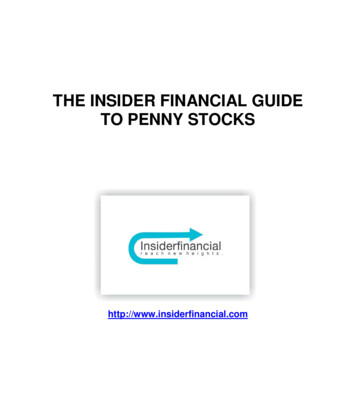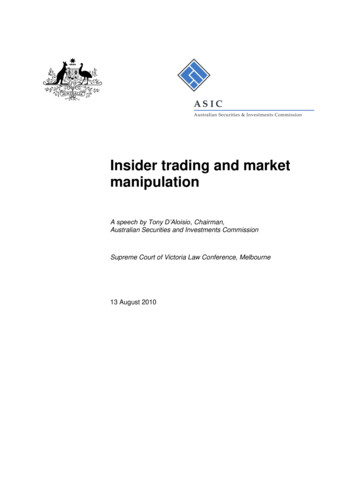
Transcription
THE INSIDER FINANCIAL GUIDETO PENNY STOCKShttp://www.insiderfinancial.com
THE PENNY STOCK BIBLEWhat Are Penny Stocks?As promised, Understanding Penny Stocks starts from the very beginning. For the purposes of understandingPenny Stocks, I will treat any share that trades under 2.00 as a penny stock. Strangely, there is no officialdefinition for penny stocks. There are three different criteria that various individuals and organizations use todefine penny stocks. What is considered a penny stock really depends with whom you are dealing.Penny stocks can be defined by:1. Price Per Share: Sometimes any shares that trade under a certain price are considered tobe penny stocks. For example, the SEC considers all stocks that trade for less than 5.00per share to be penny stock. Different individuals and organizations have their own cut-off.2. Market the Stock Trades Upon: In some schools of thought, any shares that trade on acertain market (i.e. the OTC-BB, or the OTC, or the 'Pink Sheets,' or the CDNX) are treatedas, or considered to be, penny stocks.3. Market Capitalization: Market cap is simply the total trading value of the entire company.The value of each share of a stock, multiplied by the total number of shares outstanding,equals the market cap.For example, 12,343,000 shares of ABC at 0.29 each gives ABC Corp. a market cap of 3,579,470(12,343,000 shares times 0.29 per share 3,579,470). That is kind of like saying that the company's totalvalue is 3.5 million dollars. In some cases, organizations or individuals will treat any company beneath a certainmarket cap (for example, less than 10 million) as a penny stock.Interestingly, using option 1 or 3, a company can have its shares change in price moment by moment, and maydrop in or out of the definition of 'penny stock' over time. What may be a "penny stock" when the market open inthe morning, may not be a penny stock by noon.In some cases the definition of penny stock is generated by a combination of the above criteria. For example,any stock trading on the OTC-BB with a market cap of less than 20 million is considered a penny stock.
What Are Penny Stocks?Defined by price per shareI treat any share that trades under 2.00 as a penny stock. The Securitiesand Exchange Commission (SEC) considers any stock below 5.00 pershare to be a penny stock.Defined by the market the stocktrades onSome markets that trade penny stocks include:» Over The Counter (OTC)» NASDAQ Small Cap» Pink Sheets» Over the Counter Bulletin Board (OTC-BB)» Canadian Venture Exchange (CDNX)Defined by MarketCapitalizationStocks with less than 50 million in total capitalization can be consideredpenny stocks, but this market cap cut-off varies greatly from oneorganization's definition to the next.It is worth repeating: I treat any share that trades under 2.00 as a penny stock.I have specifically developed my techniques and trading methods to apply to shares less than 2.00 in price.However, keep the other definitions in mind because what is and is not a 'penny stock' will depend on who youask. The only common characteristic that we feel holds true from one definition to the next, is that penny stocksare high risk, high reward investments.Penny stocks are high risk, high reward investments. It is easy to lose money on a penny stock investment.However, if your shares do begin to move, they can produce hundreds of percentage points of gains, and theyoften do this in only a short time frame.Penny stocks are often very volatile, and just as often unpredictable.In most cases, penny stocks are considered to have higher risk and higher potential rewards than most other'more conventional' investments. Their speculative value can be extreme, and their visibility of information and /or accessibility of operational results is usually very poor.Few financial professionals venture into the field of penny stocks because they are either unwilling or unable todo the work required to accurately predict what these highly explosive shares may do.Or perhaps some big-wig investment types feel that low-priced shares are 'beneath' them. Hmmm. I could haveretired when I was 26. Is that beneath them?
Big Stocks vs. Penny Stocks IAs you review the following differences between "blue-chip" equities and penny stocks, you may be able to seewhy professional analysts and institutional investors usually shy away from these speculative shares.The kind of money that the big players use could crack the backs of many of these penny stock companies.There would not be enough volume on the other side of their trades to enable the transaction, because somepenny stocks often trade only a few thousand dollars worth per day.The negative connotation towards penny stocks among financial industry insiders needs to be kept in context.Sure, these investments are often low-volume, inexpensive shares of unproven companies. However, that is thebeauty of penny stocks, and is partly why you can acquire such potentially rewarding stocks at such bargainprices.As well, the lack of institutional interest is one of the keys to our methodology of picking winning penny stocks.Getting involved early, then holding on as the company gets discovered and explodes in price, is partlydependent upon the previously unknown company suddenly gaining interest from bigger players.SpeculationSpeculation is based on penny stock companies having lower available information about their operations,minimal revenues, unproven management, and often an unproven product or industry.A big-name company like General Electric or Ford Motors will have very little speculative value. In other words,you will probably not make hundreds of percentage points on your shares, but instead would be happy withreturns of 10% to 20% per year.In some cases, traders even use large-cap stocks to hedge or protect their portfolios, out-perform the market,preserve their capital, or diversify their exposure.On the other hand, trading penny stocks with hopes of selling when you have realized a 20% gain might befolly. Penny stocks make their gains by the hundreds of percentages, and thousands, not by the tens.There are many bad investments in the penny stock field, so the best way to succeed is by isolating those withsuperior speculative value. The chance of buying into shares of the company that could multiply 10 or 20 or 50times in price is the whole idea of speculation.Value and PredictabilityLarge-cap companies usually have more predictable revenues and earnings. Many analysts and investorsfollow the companies, so that day to day events are quickly factored into the share price, and the stock oftenreflects a pretty accurate 'worth.'
In contrast, it is not possible to calculate the actual worth of most penny stocks. Some do not have inventories,a revenue stream, or even a proven product. The shares rise and fall based on buying and selling demand, andthat demand is driven mainly by waves of speculation.By their nature, it is nearly impossible to know what price a penny stock share should be trading at, andconventional financial ratios and industry comparisons are rarely effective measures for realizing a pennystock's tangible value.Compare Penny Stocks to More Conventional Blue-Chip StocksSpeculationValue andPredictabilityFundamental Analysisand InformationAvailabilityTechnical AnalysisVolatilitySpreadRisk / Reward RatioEase of AcquisitionRevenues andCompany Life-CyclePENNY STOCKSHighly speculative. For some penny stocks,speculation is all they have going.!!The betterpenny stock companies often see their sharessoar on speculative buying.Less actual value, greater perceived potential.Penny stocks are also very unpredictable.Poor visibility levels, lower reportingresponsibility.!!Can be researched properly ifthe Leeds Analysis method I describe inChapter Three is applied.TA methods cannot be applied to pennystocks, except for the proprietary techniquesand indicators I describe in the second half ofLeeds Analysis later in this book.Highly volatile, with more frequent profit-takingopportunities, and greater price swings.Sometimes there is a gap between prices ofbuyers and sellers.The risks are higher, while the potentialrewards are much greater.More complicated to purchase some types ofpenny stocks, such as those trading OverThe-Counter.Lower, or no actual revenues. Initial or growthstage companies.BLUE CHIPSLittle or no speculative value.Safer but boring. Very little potentialfor a price explosion.Well known, heavily followedcompanies have a wealth ofinformation available.TA can be easily applied to highvolume shares.More secure and insulated fromvolatility.High volume stocks have very littlespread between the bid (buyingoffer) and the ask (selling offer)prices.Less risk, less reward potential.Much easier to trade through yourbroker, no special commissionrates.Mature or advanced companies,less growth but greater revenuestreams.
DividendsTakeover orAcquisition TargetsPENNY STOCKSVery rarely pay or are in the position to paydividends.More likely to be taken over by anothercompany, which is usually very beneficial tothe price of the shares.Industry and SectorInfluencesEconomies of Scaleand Niche MarketingHighly exposed to sector influences, to thepotential benefit or detriment of the shares.Niche marketing is more important, becausepenny stocks can not compete with theeconomies of scale of the bigger players intheir field.Driving Factors vs.Fiscal SituationShare price is not strongly tied to fundamentalresults and the balance sheet.Irrational Spikes andProfit OpportunitiesBroker PoliciesMore frequent and extreme spikes and dips,from less provocation.For certain types of penny stocks, brokers cancharge greater commissions, or beproblematic.Gains can be seen in short time frames, fromhours or days, to weeks or months.Investment HorizonBLUE CHIPSMany blue-chip stocks paydividends.More likely to be the companypurchasing or taking over thesmaller player, which is usuallydetrimental to the price of shares.Insulated to the impacts of thesector and industry.Benefit from economies of scale,but can not respond, react, or adaptto the smaller companies quicklyenough. Often leave nichesexposed for penny stock companiesto capitalize.Fundamental results and thebalance sheet are the mostimportant factor to the share price.More stable, less volatile.Brokers will not be problematic fortrades in blue chip stocks.It often takes larger, slow-movingcompanies years for their shareprices to advance meaningfully.Fundamental Analysis and Information AvailabilityShares trading on senior exchanges must comply with regimented reporting requirements. To keep theirshareholders happy, and to maintain their exchange status, they often must detail the entire inner workings andoperational finances of their company to the public. It is simple to get the latest results from IBM, and to take itone step further you can even get estimates of future results.Depending where the penny stock trades, the disclosure level is usually anywhere from mediocre to nonexistent. There are penny stock companies which bend over backwards to inform the public of their everymove, but these are few and far between.It will take more work to acquire the information you could easily get from a larger company, and even then thedata may not be available.
Big Stocks vs. Penny Stocks IITechnical AnalysisTechnical analysis is the examination of the trading chart of a stock to look for trends, patterns, and hopefullypredict future price direction. For these methods to work accurately, the underlying stock needs to have a highlevel of trading activity. The high trading volumes in most large-cap, big name investments make technicalanalysis of the company's trading chart possible and improves the accuracy of those predictions.Penny stocks lack the critical mass of trading volume to enable standard technical analysis. For the purposes ofpenny stock investors, I was forced to develop my own proprietary methods that could be applied to thinlytraded securities, and these are detailed in Chapter Three of "Understanding Penny Stocks".Above is an example of some of the Technical Analysis indicators that can be used to attempt to predict stockprice direction.While they have little bearing on the concepts presented in Understanding Penny Stocks, they are presentedhere as an example. Some of the idicators featured above include smooth moving average, bollinger bands,momentum, relative strength index, and others.Side Note: I did not need to use all this fancy technical analysis to discover BXG (the stock featured above) justbefore it made its big move. Rather, I found BXG using Leeds Analysis and revealed it to my subscribers justbefore it multiplied in price.VolatilityPenny stocks can often undergo dramatic price swings, and often these moves can be on nothing more than alarge buy or sell order. It is not unusual to see your shares drop or spike 20% or 50% or more during a tradingday, and even return to their original starting point by the end of that same day.When a company does come out with a significant press release, for example a biotech gaining FDA approvalfor its latest drug, expect the shares to make a big move, and even potentially build upon that advance thefollowing few trading days. Price explosions of several hundred percent in a matter of hours or minutes are notuncommon.SpreadStock markets try to match up the highest bid price (to buy shares) and the lowest asking price (to sell shares).When these numbers match a trade takes place. For example, when you see a price quoted as 0.25, youknow that the last trade was when a buyer and a seller both agreed upon 0.25 for their transaction.
At all times when the bid and ask are not matching, there is a spread. For example, if the highest bid is 0.80and the lowest ask is 1.00, the spread between the two will be 20 cents.You will quickly find that penny stocks are subject to much larger spreads (on a percentage basis) than moreheavily traded stocks. It is common to see penny stocks with spreads of 15% to 30% when the buyers andsellers are not agreeing upon a price.Risk and RewardPenny stocks are considered higher risk, because uninformed or unlucky investors have lost money, andquickly.Sometimes those losses are contained to a fraction of the invested capital, but other times traders lose 100% oftheir investment (for example, if the company goes bankrupt). Companies ceasing operations, running out ofmoney, and / or closing their doors is much more common among penny stocks than other larger investments.That is why it is so important to limit your risk, and avoid the common pitfalls that so many investors blindly fallinto. Understanding Penny Stocks will help you limit your risk significantly.It is not unlike driving. Driving will always be dangerous. So, drive a Volvo, the safest car, to protect yourself.Investing will always be dangerous. So, read Understanding Penny Stocks to protect yourself. Rewards are alsomuch higher (potentially) than with other investment vehicles. Many penny stock companies have just startedout, and will one day be huge corporations. The returns a trader could make off of one of these could beenough to live off of for years.Ease of Acquisition for IndividualsYou can buy thousands of shares of penny stocks with a small investment. In contrast, it is not always withinthe means of an individual to purchase 100 shares of a 40 stock, which means that buying blue chip and largecap equity investments is not always realistic.As well, if you do have a few thousand dollars it is easier to diversify among a group of penny stock companies,instead of buying only one or two more-expensive blocks of higher priced shares.Revenues and the Company Life CycleMost companies start off with an idea or business model, raise capital, and implement their operationalstrategy.If they get this far, and many don't, they enter their growth phase. In this phase, their revenues go from nil tosome level that (usually) is still not enough to meet their expenses.
The growth phase, when companies become discovered by the public and the financial industry, is when theyusually enjoy the greatest share price movement.As a company matures, they begin looking for additional complementary products and services to sell. They gettheir fiscal situation in order, turning those revenues into earnings, and may even pay dividends.This process from new company to mature corporation takes years. Microsoft was once a two-man operation,and they had an office sign that was scribbled on a piece of cardboard. They enjoyed an explosive andarguably the most dramatic growth phase in the history of the stock market, and now have hit maturity. They donot expect to keep advancing at their explosive rate, and are looking for alliances and ways to consolidate theirindustry position.It is important to know that the majority of penny stocks are in the pre-revenue or very early growth stages.Many do not have revenues, and just as many have yet to prove that their concept or operational strategy hasany merit.Many penny stocks in this infancy stage are 'story stocks,' meaning that they have investor interest because oftheir potential. They have a great sounding 'story' or idea (for example, a new technology or drug that couldrevolutionize an industry), but have yet to prove it, or to show that they have a method to capture market shareor educate society about their concept.DividendsSome larger companies, or those with higher cash flow, pay a portion of their cash to shareholders. Pennystocks, being cash-strapped and in their growth phase by their very nature as described above in 'the companylife cycle,' generally do not.However, it has happened from time to time. I once bought shares in BVR.A on the TSE (Bovar, Toronto StockExchange) for 0.14 each. The company decided to unload a large cash position that it had on its books. Theypaid out a one time dividend of 0.16, which by itself was higher than the original purchase price.(Note: Part of my personal justification for purchasing BVR.A was that they had more cash on hand per sharethan the current trading price). I had more money than I had originally put in just from the dividend, and I stillheld the shares!Takeover or Acquisition TargetsSince the market capitalization of a penny stock company is lower, they are excellent takeover targets for biggerplayers in the same field. As well, smaller penny stock companies often merge with one another as a way toincrease sales and revenues in a bid to compete with or survive against the bigger industry players. Generally,ifa company is getting taken over their share price will benefit. If they are merging with another company, howthe share price performs will depend on the situation, and could be beneficial or detrimental.
Big Stocks vs. Penny Stocks IIIIndustry and Sector InfluencesWhile Disney (DIS on NYSE) may be impacted by trends in movie go-ers, travellers, and advertising, the day today and month to month changes in these underlying criteria do not sway the stock too dramatically.In comparison, most penny stock companies have exposure to one facet of the economy, and are highlyleveraged against that driving force. Gold penny mining stocks suffer extreme swings as the price of theprecious metal fluctuates, and a biotech company could be crushed if a competitor releases a superior drug.In other words, penny stock companies are usually one-tiered, highly leveraged entities, that suffer and enjoyextreme price fluctuations whenever their underlying industry shifts.Economies of Scale and Niche MarketingLarger companies have more resources and capital at their disposal, and usually enjoy stronger strategicalliances with bigger companies, as well as more pervasive name recognition for their product or service.This creates problems for penny stock companies looking to enter a pre-existing market that already has adominant force. In these scenarios, the penny stock company generally performs best by capturing a nichemarket, rather than going head to head with a competitor.For example, take a look at one of my favorite stocks in recent years. Paravant Computers had no hope ofsurviving a market share war with Dell, Compaq, IBM, and all the other players in their saturated sector.However, since they were in the niche market of developing rugged laptops and computer peripherals foroutdoor and military use, the company thrived and the stock soared. They enjoyed better earnings and lowerdebt loads than all of their bigger competitors, and developed name recognition and reputation in the nichemarket that mattered to them.Several times over the years I had told members of PennyStocks.com all about Paravant, and they mademoney on it each time. After September 11th, PVAT soared as military spending increased.Driving Factors vs. Fiscal SituationPenny stocks often have too much debt, no revenues, or ugly balance sheets. Looking closely at their fiscalresults can be frightening. However, investors often ignore the fundamentals of speculative companies,because of the potential the shares could enjoy if the company's product catches on.For example, Xerox once had a horrible financial situation when they first started out. However, that did nothave much impact once their technology became the standard - long before they were actually turning a profit.
Irrational Spikes and Profit OpportunitiesPenny stocks can often spike (or drop) based on the slightest provocation, even if that driving factor is oflittle significance.Pretend that a change in CEO seems like a great turn of events for an anxious trader, who disliked the oldCEO. The investor dives into the market for 10,000 worth of shares, which could result in a 50% leap inshare prices because of the buying pressure. However, the new CEO may not be enough to justify a 50%increase in the overall value and market cap of the corporation.Part of the process is to understand which driving factors are accurately priced into the shares. If you donot share our exuberant investor's faith in the new CEO, you may want to take this opportunity to exit yourposition and take profits as the stock spikes 50% higher.Broker PoliciesDue to the lack of visibility of penny stocks, the markets they trade upon, their volatility, and their riskfactors, some brokerage houses have instituted strict policies for trading these investments.Shares that they consider 'penny stocks,' which are usually stocks for 5.00 and under, are not optioneligible. This means that you cannot sell short, set stop loss orders, or buy on margin. For most tradersthis would not be an issue anyway, because these are all more exotic trading methods, and ones that Istrongly warn against.As well, depending on the stock exchange that the shares are listed on, you may not be able to use limitorders to buy or sell, and will have to take the best available market price. There is much more on buyingand selling coming up later in this chapter.Investment HorizonTraders generally tend to hold penny stocks for shorter time frames, and attempt to get their returns fromthe stock in a matter of months rather than years. Want your trading to be exciting;Have limited capital;Don't have the patience to wait for years;Want to use your profits to generate even more profits.
Picking Your Own Explosive Penny StocksA little work can go a long way.In the case of penny stocks, the amount of effort and research you put into finding the perfect investments isdirectly proportional to success.Almost all traders who get involved with penny stocks are doing so for the wrong reasons. For example, theyhear a hot tip from a friend at work, or see a small news article about a company in the paper. Unfortunately, bythe time you hear about the shares, they are already common knowledge.This is not to say that you will need to research for eight hours a day just to make money. It is quite the oppositeactually. A few moments of effort, along with the knowledge and concepts revealed in Leeds Analysis, will helpyou quickly identify which are the best penny stocks from the pool of thousands.For those of you who are willing to research extensively, the theories will be incredibly valuable.If you are not inclined to do very much work, or do not have the time to commit, these concepts become evenmore important. They will show you how to: Easily rank stocksAvoid the common mistakesPerhaps you do not want to do any research yourself at all, but instead prefer to use a professional penny stockpicking service. This is also an excellent way to proceed, as long as you decide on a service that is reliable andaccurate.I recommend that you do use the services of a professional penny stock analysis company, but besidesPennyStocks.com, I would not consider any of the other options out there to be 'professional.' Generally theyare individuals who have figured out how to program a web page, and their expertise does not go far beyondthat.A Little WorkAs I have mentioned, a little work can go a long way. However, most traders do not put in the required effort, orany effort for that matter. Those of you who are willing to do the extra due diligence or analysis will benefitgreatly from what you are about to read.Understand that 95% of penny stock companies should be considered bad or dangerous investments.However, the proven approach outlined in the next several sections of Understanding Penny Stocks makes iteasy to tell which stocks should be ruled out.
A Long WayAs you become more experienced, you will learn that a good penny stock trader can make money on good andbad penny stocks alike, simply by investing at the right time. Since every stock fluctuates, you shall see thatmoney can be made by buying even the worst companies at the right time, and money can be lost bybuying the best companies at the wrong time.Ideally you want to accumulate the best penny stock companies at the most advantageous prices. We suggestusing fundamental analysis (detailed in an upcoming section) to discover which are the best penny stockcompanies, while using technical analysis (also detailed further along in Understanding Penny Stocks) to pickthe most opportune buying prices.Different Research and Analysis Schools of ThoughtThere are many different strategies for picking winning stocks, and perhaps you have heard of most of them.From 'advanced technical analysis trading programs' to 'computer-assisted undervalued screens,' no onemethod has consistently proven effective with penny stocks.You may as well have been throwing darts at the stock page in the newspaper!For this reason, my company has developed our own proprietary research and analysis technique, whichapplies specifically to the penny stock markets. Our methodology has been working exceptionally well,and has been fine-tuned over many years to further increase its effectiveness.You are about to learn this long-secretive approach to picking winning penny stocks, called "Leeds Analysis."This technique has helped me make tremendous amounts of money, both for myself and for my subscribers.However, I first ask that you review the different research and analysis schools of thought. I believe that it isvery important to understand the numerous ways that investors have attempted to beat the market over time.The roots of my own secretive penny stock research and analysis technique stems from some of the bestpieces of the following methodologies.I feel that I must make one thing clear! The methodologies presented below were created to apply to higherpriced equities, and when applied to penny stocks they often lose their relevance and accuracy. That is whymyself and my team were forced to create our own approach to picking penny stocks, which is detailed in thenext section of Understanding Penny Stocks.Why don't conventional research techniques work for penny stocks, you ask?This is because penny stocks are an animal all of their own, and they play by significantly different rules. Wheninvestors try to take a strategy for investing and apply it to penny stocks, they are often surprised by howineffective it can be. Different Schools of Thought.
Technical AnalysisThis uses patterns in the trading chart to try to uncover trends, and then predict the future direction of shares. Itis also done in an attempt to uncover the best buying and selling opportunities and prices, as well as to predictthe future activity of the underlying stock.For example, when most stocks demonstrate what TA calls a 'cup and handle' pattern, they generally spikehigher in the subsequent weeks. Thus, a cup and handle pattern may be a good buying opportunity.What a technical analyst's desk may look like.TA is significantly limited when applied to penny stocks, as the trading volumes and low investor interest(compared to most stocks) negates most analysis patterns. TA works best on well-followed, heavy volumeshares like IBM or FORD."Conventional" TA cannot and should not be applied to penny stocks. Instead, we have developed our own TAmethodology for application specifically to penny stocks, and I detail it in upcoming sections of UnderstandingPenny Stocks.Fundamental AnalysisThis approach uses the company's financial statements. It looks at the financial numbers and ratios, as well asthe corporate situation. We feel that fundamental analysis is a great starting point for screening and researchingpenny stocks, and that it is an effective method of finding the best companies to invest in.Fundamental analysis looks at things from revenues and debt, to ratios like price/earnings and debt/equity. Itthen compares these with other stocks in general, and with direct competitors. Using fundamental analysis, youwill also look at such criteria as management team effectiveness, press releases, brand recognition, barriers toentry for new competitors to the sector, among a host of other parameters.Fundamental anal
Penny Stocks, I will treat any share that trades under 2.00 as a penny stock. Strangely, there is no official definition for penny stocks. There are three different criteria that various individuals and organizations use to define penny stocks. What is considered a penny stock really depends with whom you are dealing. Penny stocks can be defined by: 1.











